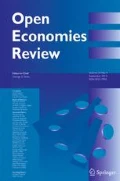Abstract
The welfare loss calculated by Romer (J Dev Econ 43:5-38, 1994) under the assumption that certain import varieties disappear a result of increased protection are an order of magnitude larger than those obtained by any other investigator. In this paper, we will argue that the key source of Romer’s result is the total absence of domestic varieties of the differentiated product. Once we allow the differentiated product to be produces at home, the results change dramatically. This allows for the realistic possibility that domestic production substitutes for imports once tariffs are imposed.









Similar content being viewed by others
Notes
Reviewing the work of Janssen (1961), Mundell (1962, p. 622) went on to state, “On a more philosophical level, there have appeared in recent years studies purporting to demonstrate that...gains from trade and the welfare gains from tariff reduction are almost negligible. Unless there is thorough theoretical re-examination of the validity of the tools on which these studies are founded...someone inevitably will draw the conclusion that economics has ceased to be important!” Reacting to the estimates by Johnson (1965), Bhagwati (1968) wrote in a similar vein and went on to offer an example in which an export subsidy that turned an importable into exportable led to halving of the national income. Balassa (1971) also applied the idea of X-efficiency to measuring the cost of protection to five developing countries.
References
Balassa B (1971) Evaluation of the system of protection. In: Balassa B et al (eds) The structure of protection in developing countries. Johns Hopkins, Baltimore
Bergsman J (1974) Commercial policy, allocative efficiency and ‘X-efficiency’. Q J Econ 88(3):409–433
Bhagwati J (1968) The theory and practice of commercial policy: departures from unified exchange rates, Special Papers in International Economics, No. 8, Princeton: Princeton University Press, 1–69 (Frank Graham Lecture, 1967)
Bhagwati J (1982) Directly unproductive profit-seeking (DUP) activities. J Polit Econ 90:988–1002
Ethier WJ (1982) National and international returns to scale in the modern theory of international trade. Am Econ Rev 72(3):389–405
Harberger A (1959) Using the resources at hand more efficiently. American Economic Review: Papers and proceedings of the seventy-first annual meetings of the American Economic Association 49(2):134–146
Harris R (1984) Applied general equilibrium analysis of small open economies with scale economies and imperfect competition. Am Econ Rev 74(5):1016–32
Janssen LH (1961) Freed trade, protection and customs union. Leiden: H. E. Stenfert Kroese
Johnson H (1965) The cost of protection and self-sufficiency. Q J Econ 79(3):356–372
Krueger AO (1974) The political economy of the rent seeking society. Am Econ Rev 64:291–303
Krugman P (1979) Increasing returns monopolistic competition and international trade. J Int Econ 9:469–480
Leibenstein H (1966) Allocative efficiency vs. ‘X-efficiency’. Am Econ Rev 56(3):392–415
Mundell RA (1962) Review of L. H. Jansen, Free trade, protection and customs unions. Am Econ Rev 52(3):621–622
Panagariya A (2004) Miracles and debacles: in defense of trade openness. The World Econ 27(8):1149–1171
Romer P (1994) New goods old theory, and the welfare costs of trade restrictions. J Dev Econ 43:5–38
Acknowledgments
The authors would like to gratefully acknowledge comments of an anonymous referee. All errors are our own.
Author information
Authors and Affiliations
Corresponding author
Rights and permissions
About this article
Cite this article
Mukerji, P., Panagariya, A. Cost of Protection: A Second Look at the Romer Variety Effect. Open Econ Rev 22, 463–477 (2011). https://doi.org/10.1007/s11079-009-9135-7
Published:
Issue Date:
DOI: https://doi.org/10.1007/s11079-009-9135-7




